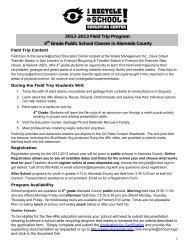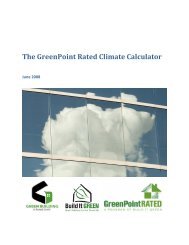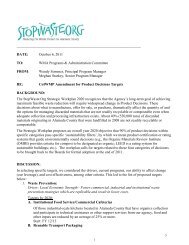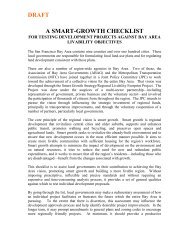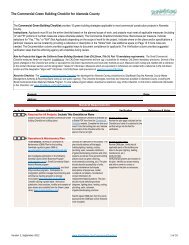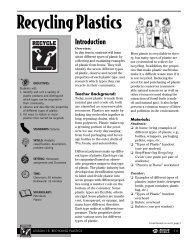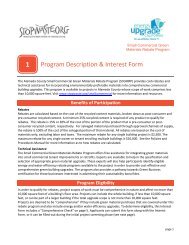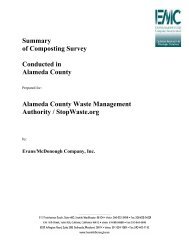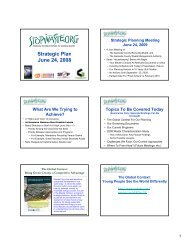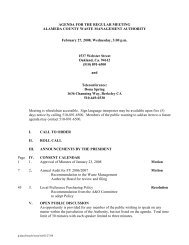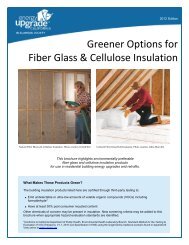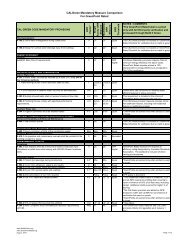Staff Report and WELO Ordinance - StopWaste.Org
Staff Report and WELO Ordinance - StopWaste.Org
Staff Report and WELO Ordinance - StopWaste.Org
- No tags were found...
You also want an ePaper? Increase the reach of your titles
YUMPU automatically turns print PDFs into web optimized ePapers that Google loves.
Draft 10-13-102. Estimated Applied Water Use. The total estimated applied water use shall not exceedthe maximum applied water allowance. Precipitation may not be used as a source of water incalculating total estimated applied water use. The total estimated applied water use shall bethe sum of the estimated applied water use calculated for each of the l<strong>and</strong>scape design planhydrozones using the following formula.EAWU = EAWU (non-SLA hydrozones) + EAWU (SLA)EAWU = Total project estimated applied water use in gallons per yearEAWU (non-SLA hydrozones) = [(47.2)(0.62)1 x [(PF x HA)/IE] calculated separatelyfor each hydrozone not meeting the definition of special l<strong>and</strong>scape area (SLA), thenadded together for all such hydrozones.EAWU (SLA) = [(47.2)(0.62)] x (SLA)47.2 = Livermore reference evapotranspiration (Eto) in inches per square foot peryear0.62 = Conversion factor from inches to gallons per square footHA = Hydrozone area (in square feet)PF = Hydrozone plant factor selected per subsection (B)(4) of this sectionIE = Hydrozone irrigation efficiency elected per subsection (B)(5) of this sectionSLA = L<strong>and</strong>scape area that meets this chapter's definition of special l<strong>and</strong>scapearea (square feet)3. Hydrozone summary. A summary table form of the l<strong>and</strong>scape <strong>and</strong> irrigation designplan's hydrozones (see subsections D <strong>and</strong> E of this section) shall be submitted <strong>and</strong> whichshall include at a minimum for each hydrozone:a. Its area in square feet <strong>and</strong> a designation (e.g., a number or letter) matchingeach hydrozone to the corresponding l<strong>and</strong>scape <strong>and</strong> irrigation design plan hydrozones.b. The highest water requirement category of its plant material <strong>and</strong> correspondingplant factor selected from the list of plant factors in subsection (B)(4) of this section; <strong>and</strong>c. Its proposed type of irrigation equipment <strong>and</strong> corresponding irrigation efficiencynumber selected from the list of irrigation efficiency numbers in subsection (B)(5) of thissection.4. Plant Factors. For the purpose of this chapter, the following plant factors shall beused for each type of plant material. These figures are based on average plant densities <strong>and</strong>general microclimate conditions of Livermore. For the purpose of this chapter, plants aredivided into high (H), moderate (M), low (L) <strong>and</strong> very low (VL) water requirement categories.The initial reference which shall be consulted for determining the category of a plant is theplant list in the Water Use Classification of L<strong>and</strong>scape Species (WUCOLS) , as defined insection 13.25.040 of this chapter), a copy of which is on file with the Department. Projectapplicants may request an alternate plant factor number for a specific plant species providedthe request is substantiated by reference material from a published source or other datasubmitted to <strong>and</strong> approved by the director. As to plant selection, that list is notcomprehensive, <strong>and</strong> the designer may use plants not on the list, provided that appropriateinformation is provided to substantiate the water requirements of those plants, such asreference material from a published source or other data acceptable to the director.Plant TypePlantFactorRecirculating water features (use 1.0surface area)1177



